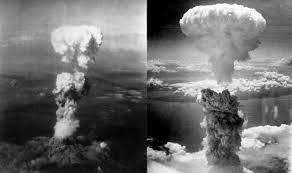On August 9, 1945, the world witnessed the second and last use of atomic weapons in warfare when the United States dropped an atomic bomb on Nagasaki, Japan. This article explores the events leading up to the bombing, the immediate aftermath, the long-term effects on the city and its inhabitants, and the broader implications of this tragic event. Background and Justification: The bombing of Nagasaki came just three days after the United States dropped the first atomic bomb on Hiroshima. The decision to use atomic weapons was made in an effort to bring a swift end to World War II and force Japan's surrender. Nagasaki, a major industrial city with a significant military presence, was chosen as the target. Immediate Impact and Destruction: At 11:02 a.m. local time, the atomic bomb, codenamed "Fat Man," exploded over Nagasaki. The blast instantly killed an estimated 40,000 people and caused widespread destruction within a radius of approximately 1.6 kilometers. The force of the explosion leveled buildings, ignited fires, and generated a massive shockwave that shattered windows and caused further devastation. Long-Term Health Effects: The atomic bomb's detonation unleashed a wave of radiation that had severe long-term health consequences for the survivors, known as hibakusha. The exposure to radiation led to various illnesses, including cancer, birth defects, and genetic mutations, affecting not only the survivors but also future generations. The hibakusha's suffering underscored the indiscriminate and long-lasting impact of nuclear weapons. Historical Significance and Calls for Nuclear Disarmament: The bombings of Hiroshima and Nagasaki marked a turning point in human history. The immense destruction and loss of life caused by these bombings led to widespread condemnation and fueled calls for nuclear disarmament. The bombings prompted a global conversation on the ethical implications of using such devastating weapons and the need for international cooperation to prevent their future use. Rebuilding and Recovery: Following the bombing, Nagasaki faced the daunting task of rebuilding and recovering from the destruction. The city's infrastructure, including hospitals, schools, and factories, had been decimated. However, with resilience and determination, the people of Nagasaki embarked on a journey of reconstruction, gradually rebuilding their city and their lives. Peace Memorial and Remembrance: To honor the victims and promote peace, the Nagasaki Peace Park and Atomic Bomb Museum were established. These sites serve as reminders of the devastating consequences of nuclear warfare and advocate for global disarmament. Every year, on August 9th, the city holds a solemn memorial ceremony to remember the victims and reaffirm its commitment to peace. Legacy and Lessons Learned: The atomic bomb dropped on Nagasaki left an enduring legacy. It highlighted the catastrophic humanitarian consequences of nuclear weapons and served as a stark reminder of the need for international efforts to prevent their use. The tragedy of Nagasaki continues to inform discussions on disarmament, nonproliferation, and the importance of diplomacy in resolving conflicts.
1945 Atom Bomb Dropped On Nagasaki
